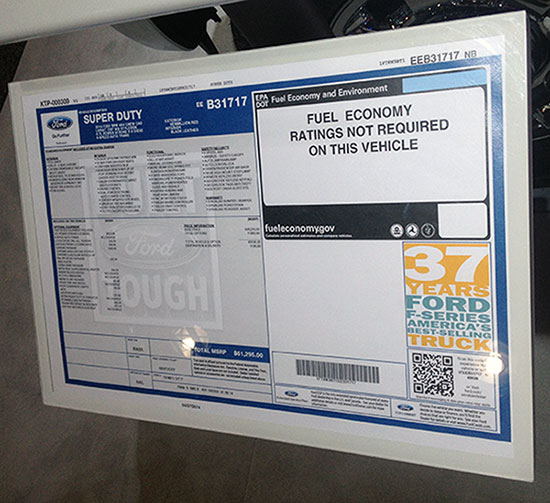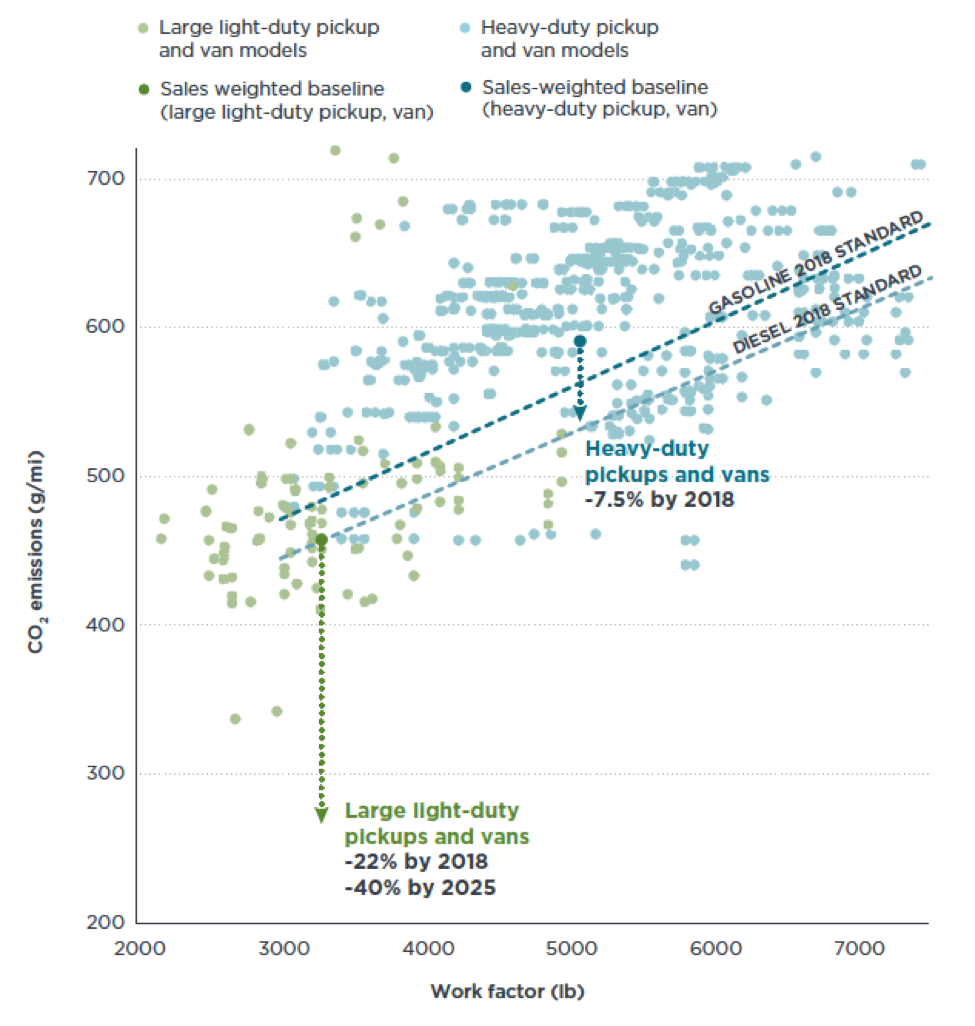Blog
When will heavy-duty pickups and vans compete on efficiency too?
If you live in the U.S., you’ve seen commercials for pickup trucks trumpeting “best-in-class” horsepower, towing, and payload capability. Get ready for a new trend in marketing pickups, as the efficiency wars increasingly encroach on the traditional horsepower wars. Believe it or not, pickup trucks are an area of major advances in efficient vehicle design and technology. Recent breakthroughs in the new EcoBoost Ford F150 and EcoDiesel Ram have led the way. Those trucks both achieve a combined city/highway fuel economy rating of 22–24 mpg on their EPA window sticker. Their fuel economy is so high that it about matches the 23-mpg average fuel economy of all the passenger cars (i.e., excluding SUVs, pickups) sold in the US as recently as 2006, before the new efficiency standards kicked in.
And, get this: The larger commercial heavy-duty pickups could follow with more substantial advances in the years ahead too.
There are over 2.3 million pickups and vans sold each year in the U.S. To give a sense of scale, that’s more than the total annual vehicle sales in France, or Canada, or South Korea. Pickups dominate this market segment, and they come in “light-duty” and “heavy-duty” versions. The heavy-duty versions have gross vehicle weight ratings (GVWR) of greater than 8,500 pounds, and account for roughly one-third of all pickup and van sales. The GVWR separates heavy-duty pickups (e.g., Ford F250/F350, Chevrolet 2500/3500, and Dodge 2500/3500) from their light-duty pickup cousins (e.g., Ford F150, Chevrolet 1500, and Dodge 1500). Light-duty pickups and vans are subject to more stringent fuel economy and emissions regulations, and new vehicles also must display the EPA fuel economy label to inform consumers about their fuel economy, fuel costs, and efficiency ratings relative to other new vehicles.
The light-duty trucks are getting major design overhauls to boost fuel economy and cut greenhouse gas emissions, as auto manufacturers gear up to meet increasingly stringent efficiency standards. For example, the new Ford F150 2.7-liter EcoBoost, the same one mentioned above, delivers about 24 mpg city, 36 mpg highway, and 28 mpg combined on the regulatory CAFE test). That’s 31% higher combined mpg than the 2010 F150 5.0-liter, and 54% higher combined mpg than the 2008 F150 5.4-liter with similar utility and performance. These very impressive efficiency gains come from the improved 6-speed automatic transmission, variable valve timing, turbocharging, direct injection, stop-start technology, and shedding 700 pounds.
How does this compare to the fuel economy of the new heavy-duty Ford F250 and F350 pickups? As the photo below of a window sticker for a Ford Super Duty pickup illustrates, nobody really knows (other than some Ford engineers, a few regulators, and any construction workers, farmers, and contractors who happen to tally the mpg for their own pickups) because the manufacturers aren’t required to publicly disclose that information. Even though the pickups and vans are now regulated under the 2014–2018 medium- and heavy-duty vehicle efficiency standards, no data has emerged on the fuel economy of each make and model. Without data, there is effectively no real “best in class.” And, because dealers also do not know, they cannot accurately advise prospective consumers on these vehicles’ fuel economy.

Fuel economy label for commercial pickup truck.
But that could change. As we move closer to Phase 2 of the U.S. medium- and heavy-duty vehicle efficiency regulation (which covers commercial pickups and vans as well as tractors, trailers, and other trucks), there are many yet-to-be-resolved issues. Data on the exact fuel economy of the current makes and models is one of the key questions, as the lack of that information represents a market failure — buyers are unable to make informed decisions about their efficiency options and potential fuel savings.
Another question is how stringent the 2020+ standards will be. Using the only public database of commercial pickup and van fuel economy statistics, developed by the EPA and NHTSA during the 2011 rulemaking, we analyzed both the light- and heavy-duty full-size pickup and van fleets. All vehicles represented in that database were tested on chassis dynamometers on the same city and highway test cycles, but the heavy-duty versions were tested at about half of their maximum payload. This new report presents the data and assesses several key factors related potential technologies and the use of separate gasoline and diesel standards. The figure below shows the currently adopted standards, and tees up the question: How stringent will the new heavy-duty vehicle regulations be?

Baseline light-duty and commercial heavy-duty vehicle CO2 reduction, showing differing stringency of the current regulations that apply to each segment.
As the chart shows, full-size light-duty pickups and vans will have to see a reduction in CO2 emissions of approximately 40% by 2025, measured from a 2010 baseline, whereas heavy-duty pickups and vans will see roughly a 10% reduction in CO2 by 2018 on a sales weighted basis. Policymakers could consider many of the same light-duty technologies (like turbocharging, direct injection, cylinder deactivation, stop-start, lightweighting, etc.) as they contemplate the future efficiency of heavy-duty pickups and vans. Whether the heavy-duty standards will, in percentage terms, go anywhere near the light-duty pickup standards’ progressive 4% per year annual efficiency improvement is unclear.
The Phase 2 proposal from EPA and NHTSA is expected in June. At that point, we should get a better sense of how efficient the heavy-duty trucks are today. It also seems like a safe bet that some new and far more efficient heavy-duty pickups are on the way. Perhaps then the heavy-duty pickups, like their light-duty counterparts, will begin to compete on efficiency too.
